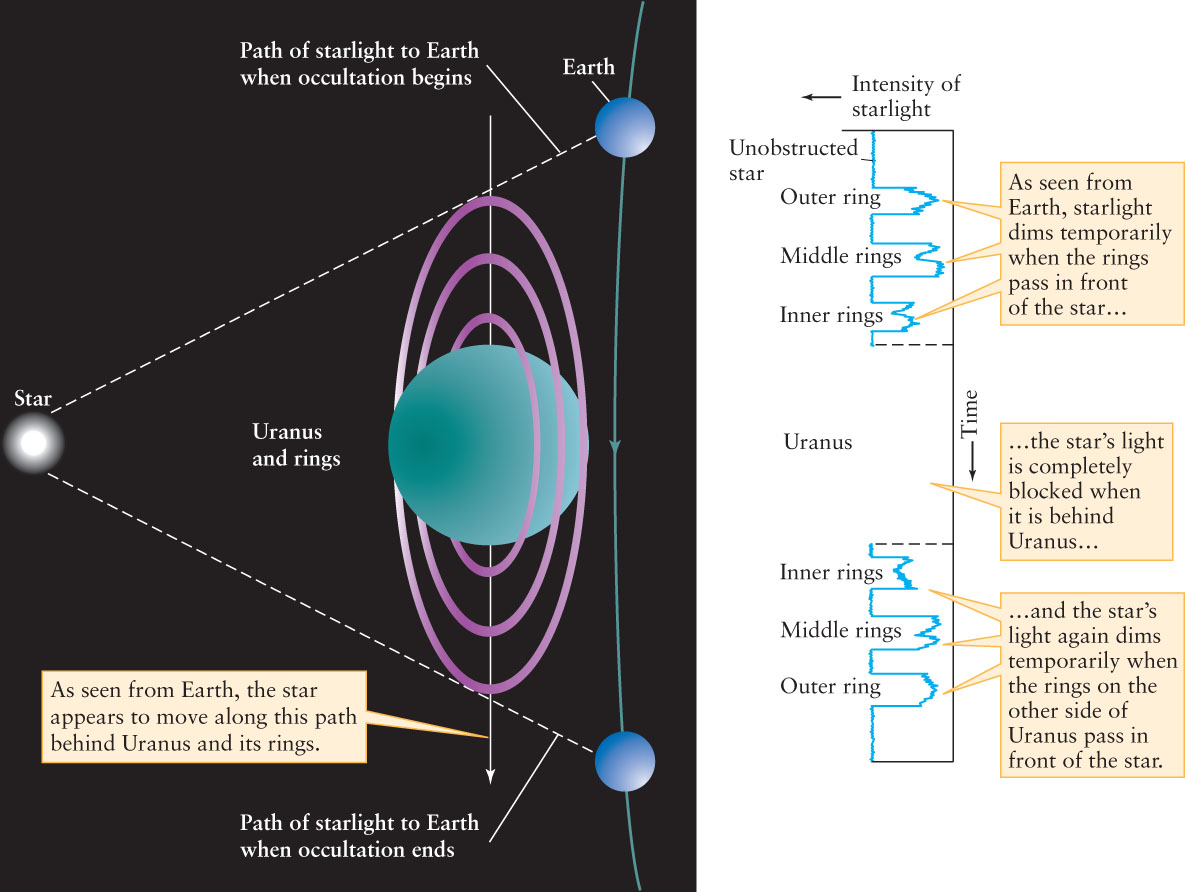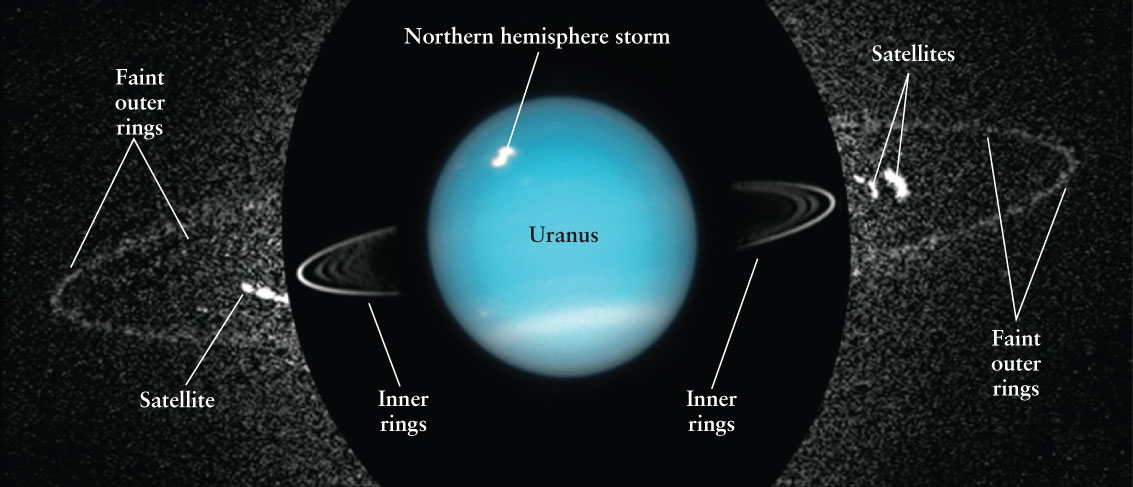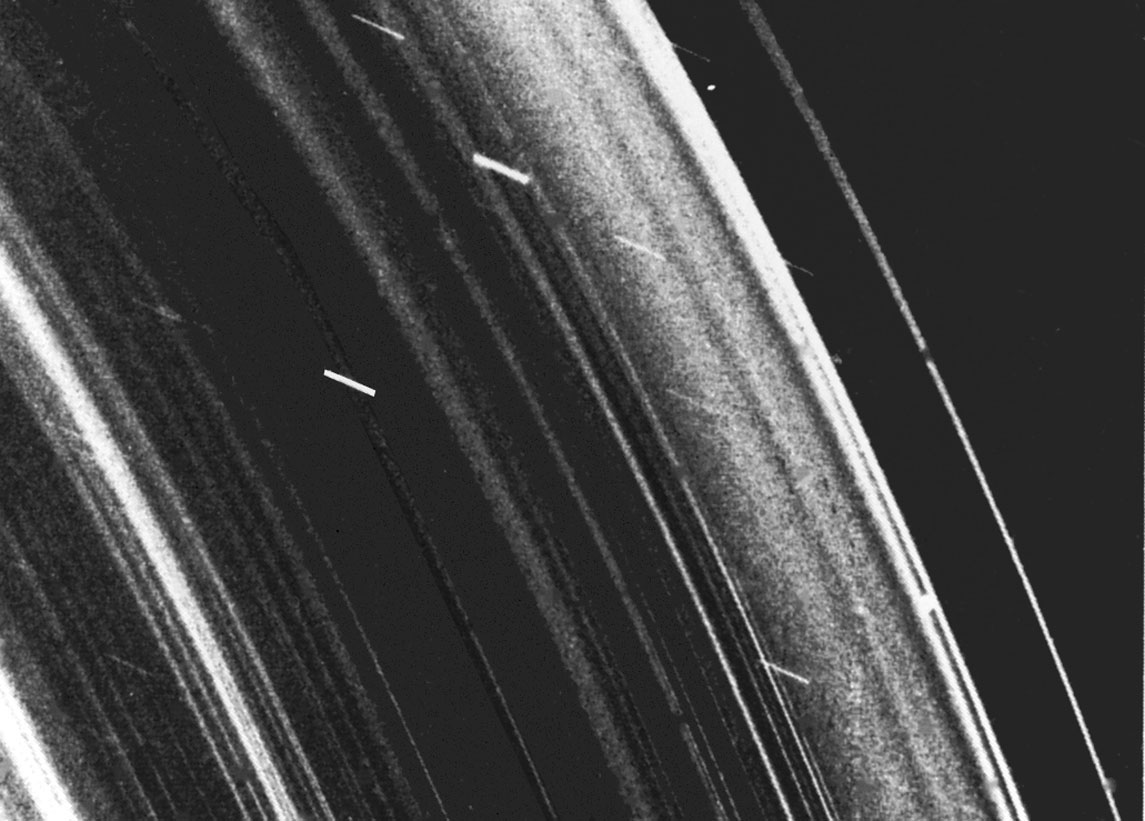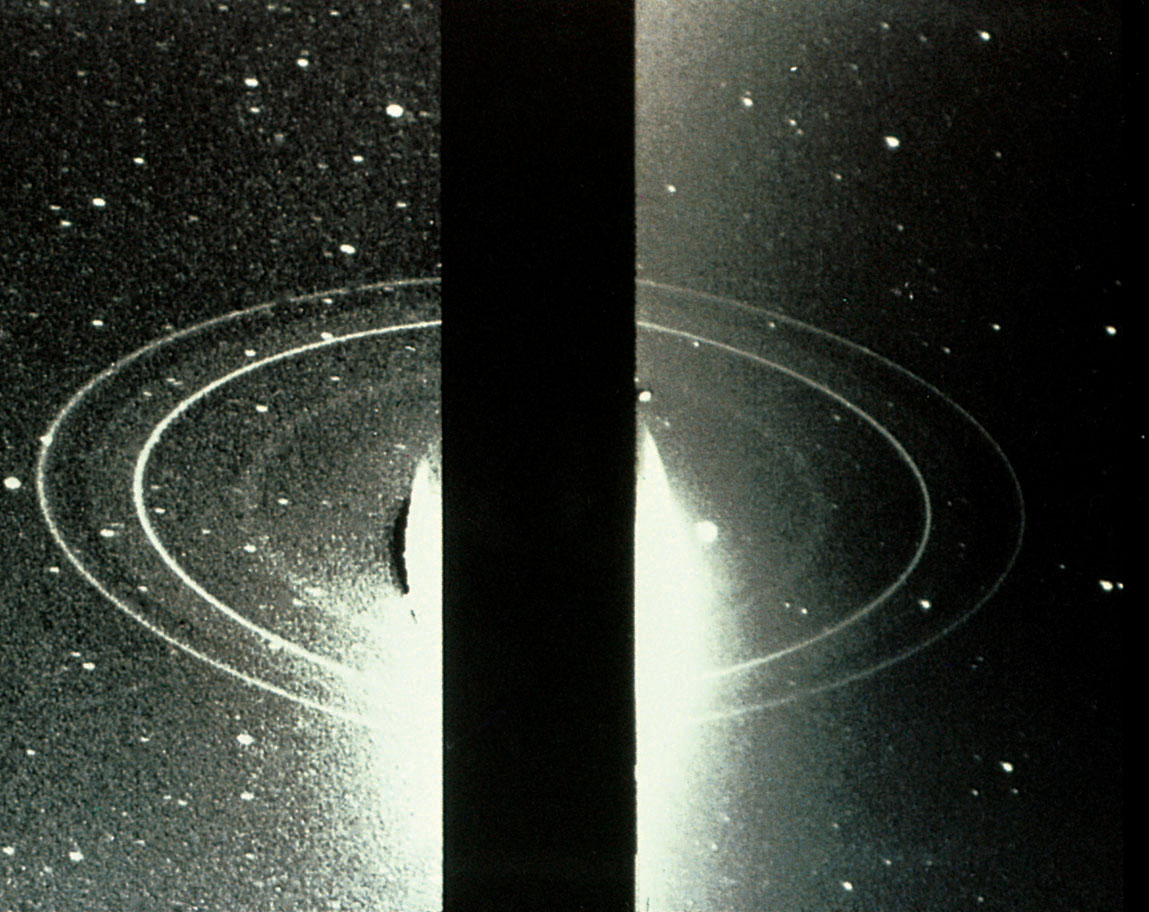14-6 Uranus and Neptune each has a system of thin, dark rings
On March 10, 1977, Uranus was scheduled to move in front of a faint star, as seen from the Indian Ocean. A team of astronomers headed by James L. Elliot of Cornell University observed this event, called an occultation, from a NASA airplane equipped with a telescope. They hoped that by measuring how long the star was hidden, they could accurately measure Uranus’s size. In addition, by carefully measuring how the starlight faded when Uranus passed in front of the star, they planned to deduce important properties of Uranus’s upper atmosphere.
The Surprising Rings of Uranus
Like the planet itself, the rings of Uranus were discovered by accident
To everyone’s surprise, the background star briefly blinked on and off several times just before the star passed behind Uranus and again immediately after (Figure 14-9). The astronomers concluded that Uranus must be surrounded by a series of nine narrow rings. In addition to these nine rings, Voyager 2 discovered two others that lie even closer to the cloudtops of Uranus. Two other extremely faint rings, much larger in diameter than any of the others, were found in 2005 using the Hubble Space Telescope (Figure 14-10).

 How the Rings of Uranus Were Discovered As seen from Earth, Uranus occasionally appears to move in front of a distant star. Such an event is called an occultation. The star’s light is completely blocked when it is behind the planet. But before and after the occultation by Uranus, the starlight dims temporarily as the rings pass in front of the star.
How the Rings of Uranus Were Discovered As seen from Earth, Uranus occasionally appears to move in front of a distant star. Such an event is called an occultation. The star’s light is completely blocked when it is behind the planet. But before and after the occultation by Uranus, the starlight dims temporarily as the rings pass in front of the star.

Uranus’s Rings from the Hubble Space Telescope Several Hubble Space Telescope images were assembled into this view of Uranus’s rings. Relatively short exposure times reveal the planet and the inner rings, while much longer exposure times were needed to reveal the outer rings. During these long exposures several of Uranus’s satellites moved noticeably, leaving bright trails on the image.
Unlike Saturn’s rings, the rings of Uranus are dark and narrow: Most are less than 10 km wide. Typical particles in Saturn’s rings are chunks of reflective water-ice the size of snowballs (a few centimeters across), but typical particles in Uranus’s rings—thought to be mostly water-ice—are 0.1 to 10 meters in size and are no more reflective than lumps of coal. It is not surprising that these narrow, dark rings escaped detection for so long. Figure 14-11 is a Voyager 2 image of the rings from the side of the planet away from the Sun, where light scattering from exceptionally small ring particles makes them more visible. (We discussed light scattering in Section 5-6 and Box 5-4.) Figure 14-10 shows the Sun-facing side of the rings.

The Shaded Side of Uranus’s Rings This view from Voyager 2, taken when the spacecraft was in Uranus’s shadow, looks back toward the Sun. Numerous fine-grained dust particles gleam in the spaces between the main rings. This dust is probably debris from collisions between larger particles in the main rings. The short horizontal streaks are star images blurred by the spacecraft’s motion during the exposure.
The Uranian rings are so dark because sunlight at Uranus is only one-quarter as intense as at Saturn. As a result, Uranus’s ring particles are so cold that they can retain some methane-ice. Scientists speculate that eons of impacts by electrons trapped in the magnetosphere of Uranus have converted this methane-ice into dark carbon compounds. This radiation darkening can account for the low reflectivity of the rings.
Uranus’s major rings are located less than 2 Uranian radii from the planet’s center, well within the planet’s Roche limit (see Section 12-9). Some sort of mechanism, possibly one involving shepherd satellites, efficiently confines particles to their narrow orbits. (In Section 12-11 we discussed how shepherd satellites help keep planetary rings narrow.) Voyager 2 searched for shepherd satellites but found only two. The others may be so small and dark that they have simply escaped detection.
The two faint rings discovered in 2005 (see Figure 14-10) are different: They lie well outside Uranus’s Roche limit. The outer of these two rings owes its existence to a miniature satellite called Mab (named for a diminutive fairy in English folklore) that orbits within this ring. Meteorites colliding with Mab knock dust off the satellite’s surface. Since Mab is so small (just 36 km in diameter) and hence has little gravity, the ejected dust escapes from the satellite and goes into orbit around Uranus, forming a ring. The inner of the two faint rings may be formed in the same way; however, no small satellite has yet been found within this ring.
The Decaying Rings of Neptune

 Neptune’s Rings The two main rings of Neptune and a faint, inner ring can easily be seen in this composite of two Voyager 2 images. There is also a faint sheet of particles whose outer edge is located between the two main rings and extends inward toward the planet. The overexposed image of Neptune itself has been blocked out.
Neptune’s Rings The two main rings of Neptune and a faint, inner ring can easily be seen in this composite of two Voyager 2 images. There is also a faint sheet of particles whose outer edge is located between the two main rings and extends inward toward the planet. The overexposed image of Neptune itself has been blocked out.
Like Uranus, Neptune is surrounded by a system of thin, dark rings that were first detected in stellar occultations. Figure 14-12 is a Voyager 2 image of Neptune’s rings. The ring particles vary in size from a few micrometers (1 μm = 10−6 m) to about 10 meters. As for Uranus’s rings, the particles that make up Neptune’s rings reflect very little light because they have undergone radiation darkening.
In 2002 and 2003, a team led by Imke de Pater of the University of California, Berkeley, used the 10-meter Keck telescope in Hawaii to observe in detail the rings of Neptune. Remarkably, they found that all of the rings had become fainter since the Voyager 2 flyby in 1989. Apparently, the rings are losing particles faster then new ones are being added. If the rings continue to decay at the same rate, one of them may vanish completely within a century. More research into the nature of Neptune’s rings is needed to explain this curious and rapid decay.
CONCEPT CHECK 14-6
Why are Uranus’s rings so much more difficult to see than Saturn’s rings?
Due to radiation darkening, Uranian rings are black as coal, unlike Saturn’s icy light-reflecting rings. Uranus’s rings are also very narrow, at about 10 km wide, compared to rings on Saturn that can be over 1000 times wider.